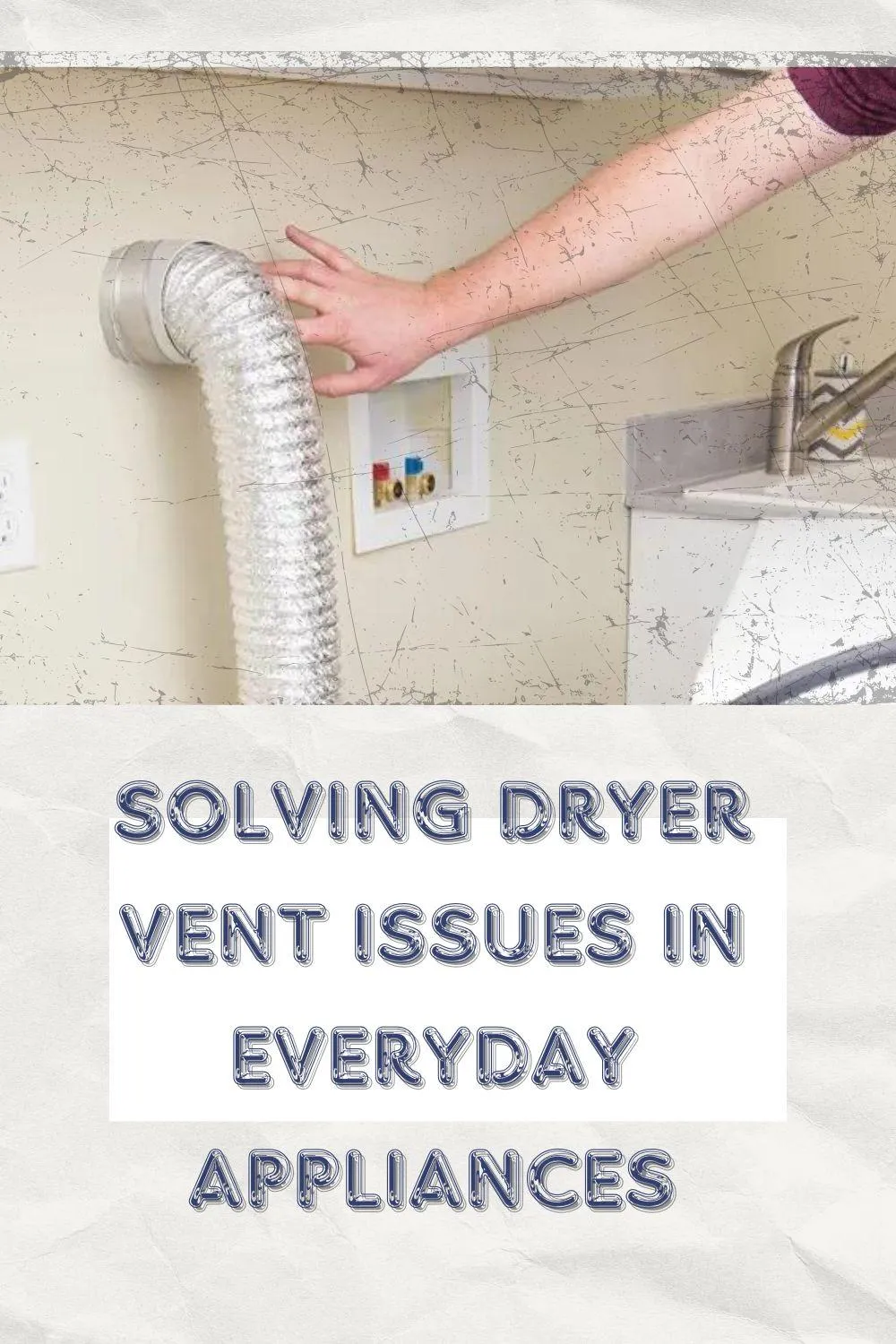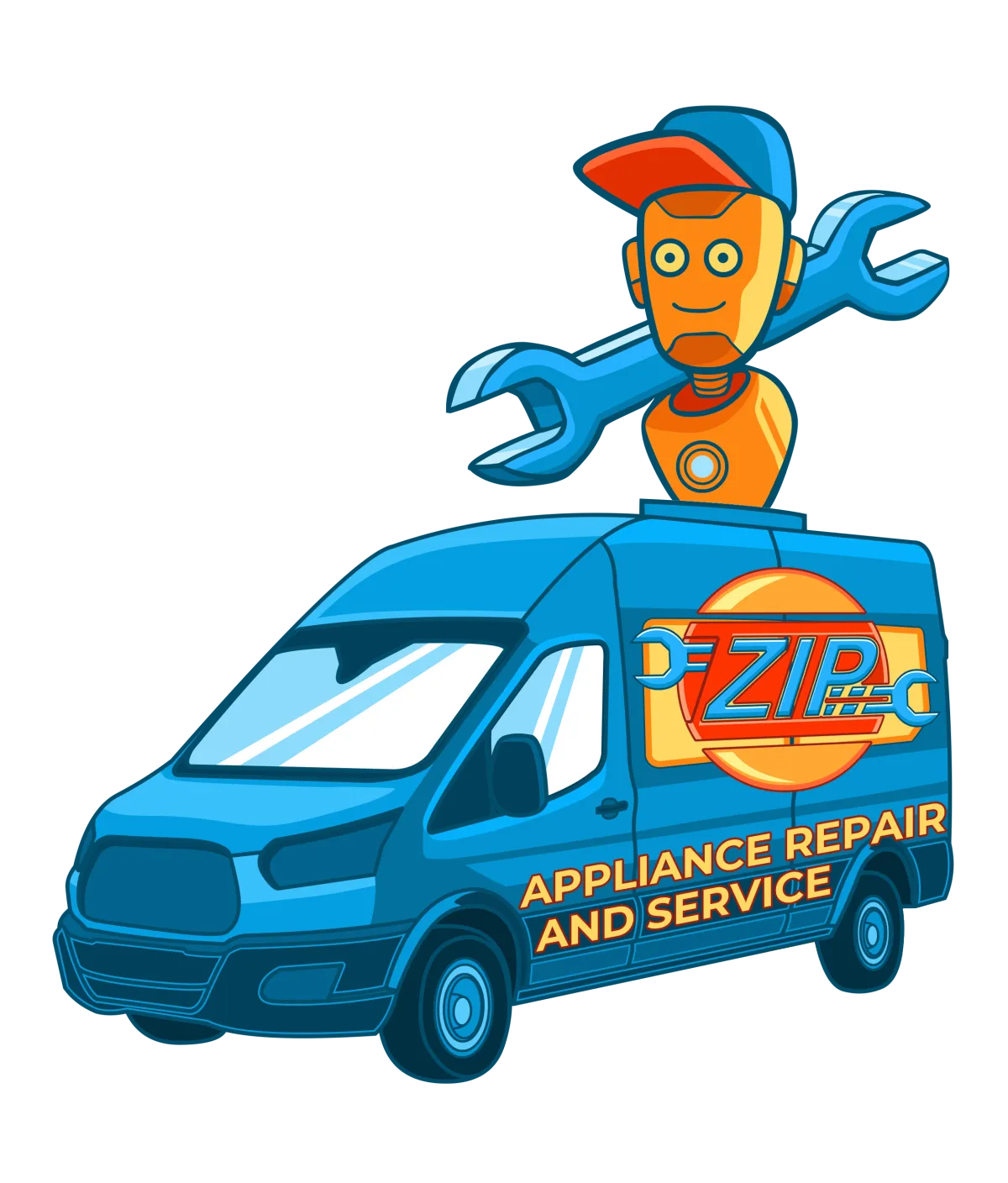Phone: (559) 272-4265
Appliance Repair Tips For Bakersfield, CA Residents

Solving Dryer Vent Issues in Everyday Appliances
"Unlock the secrets to a safer, more efficient home with our comprehensive guide to solving dryer vent issues. From understanding the importance of proper maintenance to practical DIY solutions and expert tips, our blog empowers you to safeguard your appliances and your family's well-being."- Appliance Boss
Introduction:
When it comes to maintaining the efficiency and safety of your home, the humble dryer vent is often overlooked. However, this critical component plays a vital role in ensuring your appliances function optimally. In this article, we'll explore the importance of dryer vents, common issues that can arise, and practical solutions for keeping them in top condition.
Understanding the Importance of Dryer Vents
Why Dryer Vents Matter for Appliance Efficiency
Dryer vents are essential for the proper functioning of your dryer. They expel hot, moist air from the dryer to the outside of your home. Without an efficient vent, this air would have nowhere to go, leading to longer drying times, increased energy consumption, and potential damage to the appliance itself.

The Hidden Dangers of Neglected Dryer Vents
Neglected dryer vents can become a serious hazard. Over time, lint and debris can accumulate, creating blockages that not only reduce efficiency but also pose a significant fire risk. Additionally, poor ventilation can lead to mold growth and other health issues due to excess moisture.
Common Dryer Vent Issues in Everyday Appliances
Blockages and Clogs
One of the most frequent problems with dryer vents is blockages. Lint, dust, and other debris can accumulate in the vent, restricting airflow and causing the dryer to overheat.
Poor Ventilation
Improper installation or poor design can result in inadequate ventilation. This not only affects the dryer's efficiency but can also lead to increased humidity levels in your home, promoting mold growth.
Lint Buildup
Lint buildup is a common issue that can lead to blockages. It can also become a fire hazard if not regularly cleaned out. Lint traps capture only a fraction of the lint produced, with the rest potentially accumulating in the vent.
Damaged or Disconnected Vents
Physical damage to the vent, such as cracks or holes, can lead to leaks. Disconnected vents, on the other hand, fail to direct hot air outside, causing it to recirculate within your home.
Signs Your Dryer Vent Needs Attention
Longer Drying Times
If your dryer takes longer than usual to dry clothes, it could be a sign of a blocked vent. The reduced airflow prevents the dryer from operating efficiently.
Unusual Odors
A burning smell during or after a drying cycle is a clear indicator of lint buildup, which can overheat and potentially ignite.
Excessive Lint
Finding lint around the dryer or on clothes even after a cycle suggests that the vent system is not effectively removing lint from the dryer.
Overheating Appliances
An overheating dryer is a dangerous sign. It indicates that the hot air is not being expelled properly, which can lead to a fire.
Preventative Measures to Avoid Dryer Vent Issues
Regular Cleaning Schedules
Establishing a regular cleaning schedule for your dryer vent can prevent buildup and blockages. Aim to clean the vent every three to six months.
Choosing the Right Venting Materials
Selecting high-quality, durable venting materials can significantly reduce the risk of damage and improve overall efficiency. Look for materials that are resistant to crushing and tearing.
Proper Installation Techniques
Ensuring your dryer vent is correctly installed is crucial. Proper installation prevents leaks and ensures optimal airflow. It's best to have a professional handle the installation to avoid common pitfalls.
DIY Solutions for Minor Dryer Vent Problems
Simple Steps for Clearing Blockages
To clear minor blockages, disconnect the vent from the dryer and use a vent brush or vacuum to remove lint and debris. Be thorough and ensure all parts of the vent are clear.
How to Safely Remove Lint Buildup
Regularly clean the lint trap after each use. For a deeper clean, use a vacuum to remove any lint that has accumulated around the trap and vent opening.
Inspecting and Repairing Vents at Home
Regularly inspect the vent for any signs of damage or disconnection. Small cracks can be sealed with foil tape, but significant damage may require professional repair.
When to Call a Professional
Identifying Complex Dryer Vent Issues
If you've tried DIY solutions but still experience problems, it may be time to call a professional. Complex issues such as significant blockages or structural problems require expert intervention.
Benefits of Professional Cleaning Services
Professional cleaning services offer thorough cleaning that goes beyond DIY efforts. They have specialized tools and expertise to ensure your vent is completely clear and functioning properly.
Cost-Effective Solutions from Experts
While professional services come at a cost, they can save you money in the long run by preventing costly repairs and improving energy efficiency.
Tools and Supplies for Dryer Vent Maintenance
Essential Cleaning Tools
Invest in a good quality vent brush, vacuum with hose attachment, and a screwdriver for regular maintenance tasks.
Recommended Venting Materials
Choose metal ducting over plastic for durability and safety. Flexible metal ducts are preferred for their ease of installation and efficiency.
Safety Gear for DIY Maintenance
When performing maintenance, use gloves, a dust mask, and safety glasses to protect yourself from lint and debris.
Step-by-Step Guide to Cleaning Your Dryer Vent
Preparing Your Dryer for Cleaning
Unplug the dryer and move it away from the wall. Disconnect the vent from the dryer and the wall vent.
Disconnecting and Inspecting the Vent
Carefully detach the vent and inspect it for any visible blockages or damage. Look inside both ends of the vent and use a flashlight if needed.
Removing Lint and Debris
Use your vent brush to clean the inside of the vent, reaching as far as possible. Follow up with a vacuum to remove any remaining debris.
Reconnecting and Testing the Vent
Reconnect the vent securely to both the dryer and the wall. Push the dryer back into place, plug it in, and run a test cycle to ensure proper airflow.
Ensuring Proper Ventilation in Your Laundry Room
Importance of Adequate Airflow
Proper airflow is crucial for efficient drying and preventing moisture buildup. Ensure your laundry room is well-ventilated and free from obstructions.
Tips for Improving Ventilation
Keep the area around the dryer clear, install a vent fan if necessary, and consider using a dehumidifier to control moisture levels.
Ventilation Solutions for Small Spaces
In tight spaces, consider using venting systems designed for limited areas, such as periscope vents, which allow the dryer to be placed closer to the wall.
The Role of Dryer Vent Filters
Types of Dryer Vent Filters
There are several types of filters, including external lint traps and secondary lint filters, which provide additional layers of protection.
Benefits of Using Filters
Using filters can help capture more lint, reducing the risk of blockages and improving overall efficiency.
How to Maintain and Replace Filters
Regularly check and clean filters according to the manufacturer's instructions. Replace them as needed to ensure optimal performance.
Troubleshooting Persistent Dryer Vent Issues
Identifying Persistent Problems
If issues persist despite regular maintenance, there may be underlying problems such as improper installation or significant damage.
Advanced Solutions for Stubborn Issues
For stubborn issues, consider hiring a professional to assess and address the problem. They can identify and fix complex issues that DIY efforts might miss.
When Replacement is Necessary
If the vent is severely damaged or repeatedly problematic, it might be time to replace it entirely. Choose high-quality materials for the replacement to prevent future issues.
Impact of Dryer Vent Issues on Energy Efficiency
How Clogged Vents Increase Energy Consumption
Clogged vents force the dryer to work harder, using more energy and taking longer to dry clothes. This increases utility bills and reduces the appliance's lifespan.
Ways to Improve Energy Efficiency
Regular maintenance, using appropriate venting materials, and ensuring proper installation can significantly improve energy efficiency.
Long-Term Savings from Proper Vent Maintenance
Investing in regular maintenance can lead to substantial savings over time by reducing energy consumption and preventing costly repairs.
Safety Concerns Related to Faulty Dryer Vents
Fire Hazards and Prevention
Lint is highly flammable, and a clogged vent can ignite easily. Regular cleaning and using metal venting materials can prevent fires.
Health Risks from Poor Ventilation
Poor ventilation can lead to mold growth and indoor air quality issues, posing health risks. Ensure proper airflow to maintain a healthy environment.
Ensuring Appliance Safety
Regularly inspect and maintain your dryer and vent system to ensure safe operation and prevent accidents.
Environmental Benefits of Maintaining Dryer Vents
Reducing Energy Consumption
Efficient dryer vents reduce energy use, contributing to lower greenhouse gas emissions and a smaller carbon footprint.
Lowering Carbon Footprint
By maintaining your dryer vent, you can reduce your household's environmental impact, making a positive contribution to sustainability.
Sustainable Appliance Practices
Adopting regular maintenance habits and using eco-friendly materials supports sustainable living and appliance longevity.
Comparing Dryer Vent Maintenance Products
Top-Rated Cleaning Kits
Explore the best cleaning kits on the market, comparing features, effectiveness, and user reviews to find the right one for your needs.
Best Venting Materials
Discover the top venting materials recommended by experts for their durability, safety, and efficiency.
Customer Reviews and Recommendations
Read customer reviews and expert recommendations to make informed decisions about dryer vent maintenance products.
Case Studies: Real-Life Dryer Vent Solutions
Common Issues and Their Solutions
Learn from real-life examples of common dryer vent issues and how they were successfully resolved.
Success Stories from Homeowners
Read success stories from homeowners who have tackled dryer vent problems and improved their appliance performance.
Lessons Learned from Case Studies
Gain valuable insights and lessons from these case studies to apply to your own dryer vent maintenance routine.
Frequently Asked Questions About Dryer Vents
Common Concerns and Answers
Address common questions and concerns about dryer vent maintenance, providing clear and concise answers.
Expert Tips for Everyday Maintenance
Get expert tips and advice for maintaining your dryer vent, ensuring efficient and safe operation.
Resources for Further Reading
Find additional resources, articles, and guides for in-depth information on dryer vent maintenance and safety.
Future Trends in Dryer Vent Technology
Innovations in Venting Systems
Explore the latest innovations in dryer vent technology, including new materials and designs that improve efficiency and safety.
Smart Dryer Vent Solutions
Learn about smart dryer vent solutions that offer automated maintenance and monitoring for optimal performance.
The Future of Home Appliance Maintenance
Discover how advancements in technology are shaping the future of home appliance maintenance, making it easier and more efficient.
Conclusion
The Benefits of Regular Dryer Vent Maintenance
Regular dryer vent maintenance offers numerous benefits, including improved appliance performance, increased energy efficiency, and enhanced home safety.
Encouraging a Proactive Approach to Dryer Vent Care
Adopt simple habits for ongoing maintenance, utilize community resources and support, and stay proactive in caring for your dryer vent to ensure long-term benefits.
Final Thoughts and Recommendations
In conclusion, regular dryer vent maintenance is essential for the efficiency, safety, and longevity of your appliances. By following the tips and advice in this article, you can keep your dryer vent in top condition and enjoy the peace of mind that comes with a well-maintained home. For expert assistance, contact Zip Appliance and Plumbing Repair at (661) 387-2282 or visit our website at www.ziprepairservice.com. Trust Zip Appliance and Plumbing Repair for all your appliance maintenance needs.

Solving Dryer Vent Issues in Everyday Appliances
"Unlock the secrets to a safer, more efficient home with our comprehensive guide to solving dryer vent issues. From understanding the importance of proper maintenance to practical DIY solutions and expert tips, our blog empowers you to safeguard your appliances and your family's well-being."- Appliance Boss
Introduction:
When it comes to maintaining the efficiency and safety of your home, the humble dryer vent is often overlooked. However, this critical component plays a vital role in ensuring your appliances function optimally. In this article, we'll explore the importance of dryer vents, common issues that can arise, and practical solutions for keeping them in top condition.
Understanding the Importance of Dryer Vents
Why Dryer Vents Matter for Appliance Efficiency
Dryer vents are essential for the proper functioning of your dryer. They expel hot, moist air from the dryer to the outside of your home. Without an efficient vent, this air would have nowhere to go, leading to longer drying times, increased energy consumption, and potential damage to the appliance itself.

The Hidden Dangers of Neglected Dryer Vents
Neglected dryer vents can become a serious hazard. Over time, lint and debris can accumulate, creating blockages that not only reduce efficiency but also pose a significant fire risk. Additionally, poor ventilation can lead to mold growth and other health issues due to excess moisture.
Common Dryer Vent Issues in Everyday Appliances
Blockages and Clogs
One of the most frequent problems with dryer vents is blockages. Lint, dust, and other debris can accumulate in the vent, restricting airflow and causing the dryer to overheat.
Poor Ventilation
Improper installation or poor design can result in inadequate ventilation. This not only affects the dryer's efficiency but can also lead to increased humidity levels in your home, promoting mold growth.
Lint Buildup
Lint buildup is a common issue that can lead to blockages. It can also become a fire hazard if not regularly cleaned out. Lint traps capture only a fraction of the lint produced, with the rest potentially accumulating in the vent.
Damaged or Disconnected Vents
Physical damage to the vent, such as cracks or holes, can lead to leaks. Disconnected vents, on the other hand, fail to direct hot air outside, causing it to recirculate within your home.
Signs Your Dryer Vent Needs Attention
Longer Drying Times
If your dryer takes longer than usual to dry clothes, it could be a sign of a blocked vent. The reduced airflow prevents the dryer from operating efficiently.
Unusual Odors
A burning smell during or after a drying cycle is a clear indicator of lint buildup, which can overheat and potentially ignite.
Excessive Lint
Finding lint around the dryer or on clothes even after a cycle suggests that the vent system is not effectively removing lint from the dryer.
Overheating Appliances
An overheating dryer is a dangerous sign. It indicates that the hot air is not being expelled properly, which can lead to a fire.
Preventative Measures to Avoid Dryer Vent Issues
Regular Cleaning Schedules
Establishing a regular cleaning schedule for your dryer vent can prevent buildup and blockages. Aim to clean the vent every three to six months.
Choosing the Right Venting Materials
Selecting high-quality, durable venting materials can significantly reduce the risk of damage and improve overall efficiency. Look for materials that are resistant to crushing and tearing.
Proper Installation Techniques
Ensuring your dryer vent is correctly installed is crucial. Proper installation prevents leaks and ensures optimal airflow. It's best to have a professional handle the installation to avoid common pitfalls.
DIY Solutions for Minor Dryer Vent Problems
Simple Steps for Clearing Blockages
To clear minor blockages, disconnect the vent from the dryer and use a vent brush or vacuum to remove lint and debris. Be thorough and ensure all parts of the vent are clear.
How to Safely Remove Lint Buildup
Regularly clean the lint trap after each use. For a deeper clean, use a vacuum to remove any lint that has accumulated around the trap and vent opening.
Inspecting and Repairing Vents at Home
Regularly inspect the vent for any signs of damage or disconnection. Small cracks can be sealed with foil tape, but significant damage may require professional repair.
When to Call a Professional
Identifying Complex Dryer Vent Issues
If you've tried DIY solutions but still experience problems, it may be time to call a professional. Complex issues such as significant blockages or structural problems require expert intervention.
Benefits of Professional Cleaning Services
Professional cleaning services offer thorough cleaning that goes beyond DIY efforts. They have specialized tools and expertise to ensure your vent is completely clear and functioning properly.
Cost-Effective Solutions from Experts
While professional services come at a cost, they can save you money in the long run by preventing costly repairs and improving energy efficiency.
Tools and Supplies for Dryer Vent Maintenance
Essential Cleaning Tools
Invest in a good quality vent brush, vacuum with hose attachment, and a screwdriver for regular maintenance tasks.
Recommended Venting Materials
Choose metal ducting over plastic for durability and safety. Flexible metal ducts are preferred for their ease of installation and efficiency.
Safety Gear for DIY Maintenance
When performing maintenance, use gloves, a dust mask, and safety glasses to protect yourself from lint and debris.
Step-by-Step Guide to Cleaning Your Dryer Vent
Preparing Your Dryer for Cleaning
Unplug the dryer and move it away from the wall. Disconnect the vent from the dryer and the wall vent.
Disconnecting and Inspecting the Vent
Carefully detach the vent and inspect it for any visible blockages or damage. Look inside both ends of the vent and use a flashlight if needed.
Removing Lint and Debris
Use your vent brush to clean the inside of the vent, reaching as far as possible. Follow up with a vacuum to remove any remaining debris.
Reconnecting and Testing the Vent
Reconnect the vent securely to both the dryer and the wall. Push the dryer back into place, plug it in, and run a test cycle to ensure proper airflow.
Ensuring Proper Ventilation in Your Laundry Room
Importance of Adequate Airflow
Proper airflow is crucial for efficient drying and preventing moisture buildup. Ensure your laundry room is well-ventilated and free from obstructions.
Tips for Improving Ventilation
Keep the area around the dryer clear, install a vent fan if necessary, and consider using a dehumidifier to control moisture levels.
Ventilation Solutions for Small Spaces
In tight spaces, consider using venting systems designed for limited areas, such as periscope vents, which allow the dryer to be placed closer to the wall.
The Role of Dryer Vent Filters
Types of Dryer Vent Filters
There are several types of filters, including external lint traps and secondary lint filters, which provide additional layers of protection.
Benefits of Using Filters
Using filters can help capture more lint, reducing the risk of blockages and improving overall efficiency.
How to Maintain and Replace Filters
Regularly check and clean filters according to the manufacturer's instructions. Replace them as needed to ensure optimal performance.
Troubleshooting Persistent Dryer Vent Issues
Identifying Persistent Problems
If issues persist despite regular maintenance, there may be underlying problems such as improper installation or significant damage.
Advanced Solutions for Stubborn Issues
For stubborn issues, consider hiring a professional to assess and address the problem. They can identify and fix complex issues that DIY efforts might miss.
When Replacement is Necessary
If the vent is severely damaged or repeatedly problematic, it might be time to replace it entirely. Choose high-quality materials for the replacement to prevent future issues.
Impact of Dryer Vent Issues on Energy Efficiency
How Clogged Vents Increase Energy Consumption
Clogged vents force the dryer to work harder, using more energy and taking longer to dry clothes. This increases utility bills and reduces the appliance's lifespan.
Ways to Improve Energy Efficiency
Regular maintenance, using appropriate venting materials, and ensuring proper installation can significantly improve energy efficiency.
Long-Term Savings from Proper Vent Maintenance
Investing in regular maintenance can lead to substantial savings over time by reducing energy consumption and preventing costly repairs.
Safety Concerns Related to Faulty Dryer Vents
Fire Hazards and Prevention
Lint is highly flammable, and a clogged vent can ignite easily. Regular cleaning and using metal venting materials can prevent fires.
Health Risks from Poor Ventilation
Poor ventilation can lead to mold growth and indoor air quality issues, posing health risks. Ensure proper airflow to maintain a healthy environment.
Ensuring Appliance Safety
Regularly inspect and maintain your dryer and vent system to ensure safe operation and prevent accidents.
Environmental Benefits of Maintaining Dryer Vents
Reducing Energy Consumption
Efficient dryer vents reduce energy use, contributing to lower greenhouse gas emissions and a smaller carbon footprint.
Lowering Carbon Footprint
By maintaining your dryer vent, you can reduce your household's environmental impact, making a positive contribution to sustainability.
Sustainable Appliance Practices
Adopting regular maintenance habits and using eco-friendly materials supports sustainable living and appliance longevity.
Comparing Dryer Vent Maintenance Products
Top-Rated Cleaning Kits
Explore the best cleaning kits on the market, comparing features, effectiveness, and user reviews to find the right one for your needs.
Best Venting Materials
Discover the top venting materials recommended by experts for their durability, safety, and efficiency.
Customer Reviews and Recommendations
Read customer reviews and expert recommendations to make informed decisions about dryer vent maintenance products.
Case Studies: Real-Life Dryer Vent Solutions
Common Issues and Their Solutions
Learn from real-life examples of common dryer vent issues and how they were successfully resolved.
Success Stories from Homeowners
Read success stories from homeowners who have tackled dryer vent problems and improved their appliance performance.
Lessons Learned from Case Studies
Gain valuable insights and lessons from these case studies to apply to your own dryer vent maintenance routine.
Frequently Asked Questions About Dryer Vents
Common Concerns and Answers
Address common questions and concerns about dryer vent maintenance, providing clear and concise answers.
Expert Tips for Everyday Maintenance
Get expert tips and advice for maintaining your dryer vent, ensuring efficient and safe operation.
Resources for Further Reading
Find additional resources, articles, and guides for in-depth information on dryer vent maintenance and safety.
Future Trends in Dryer Vent Technology
Innovations in Venting Systems
Explore the latest innovations in dryer vent technology, including new materials and designs that improve efficiency and safety.
Smart Dryer Vent Solutions
Learn about smart dryer vent solutions that offer automated maintenance and monitoring for optimal performance.
The Future of Home Appliance Maintenance
Discover how advancements in technology are shaping the future of home appliance maintenance, making it easier and more efficient.
Conclusion
The Benefits of Regular Dryer Vent Maintenance
Regular dryer vent maintenance offers numerous benefits, including improved appliance performance, increased energy efficiency, and enhanced home safety.
Encouraging a Proactive Approach to Dryer Vent Care
Adopt simple habits for ongoing maintenance, utilize community resources and support, and stay proactive in caring for your dryer vent to ensure long-term benefits.
Final Thoughts and Recommendations
In conclusion, regular dryer vent maintenance is essential for the efficiency, safety, and longevity of your appliances. By following the tips and advice in this article, you can keep your dryer vent in top condition and enjoy the peace of mind that comes with a well-maintained home. For expert assistance, contact Zip Appliance and Plumbing Repair at (661) 387-2282 or visit our website at www.ziprepairservice.com. Trust Zip Appliance and Plumbing Repair for all your appliance maintenance needs.
If your dryer has been giving you problems, contact Zip Appliance Repair & Service at (661) 387-2282

Appliance Repair In A Zip
If you need a dryer repair call our Team at (661) 387-2282, or visit our online scheduling page to request service.
Appliance Repair
Plumbing Repair Services
HAVE A QUESTION, CALL (661) 387-2282

Online Offers
Take advantage of our online discount offers - save time and money...

Residential & Commercial appliances
See what our company can do for you

Appliance Repair Tips
If your appliance is not working properly...

1405 Commercial Way ste 100
Bakersfield, CA 93309
Lic # 1116346
Equipment We Sevice
- A Call To Confirm Your Appointment Time
- A Email Detailing Your Assigned Technician
- Information Needed Before The Repair Can Be Started
- An Estimate Of Work To Be Done
© 2025 ZIP APPLIANCE REPAIR & SERVICE LLC








